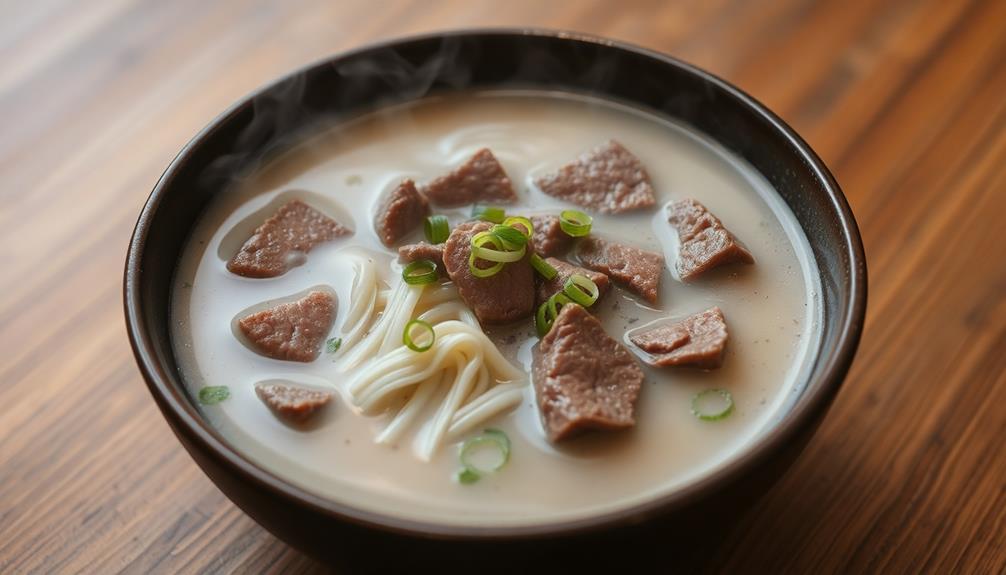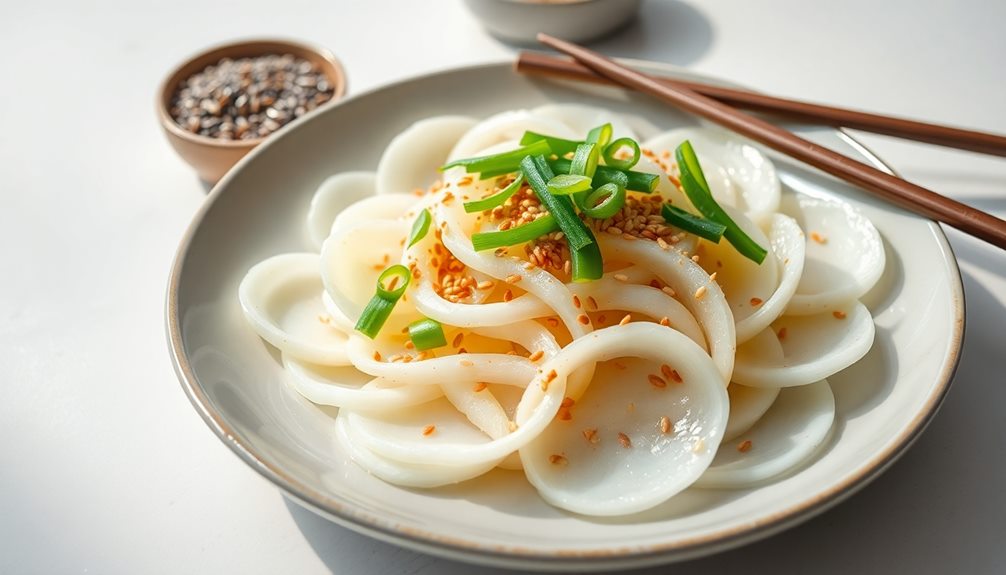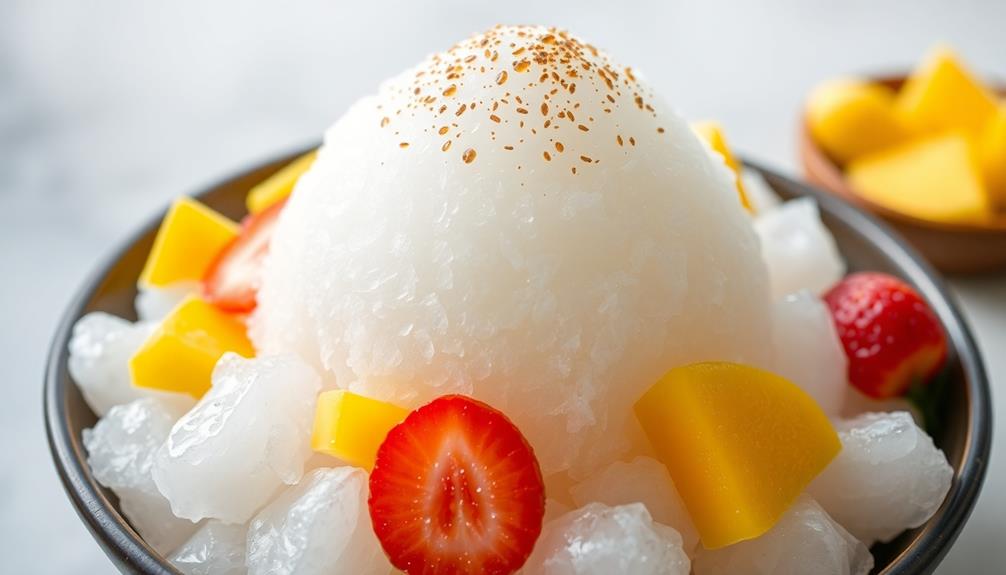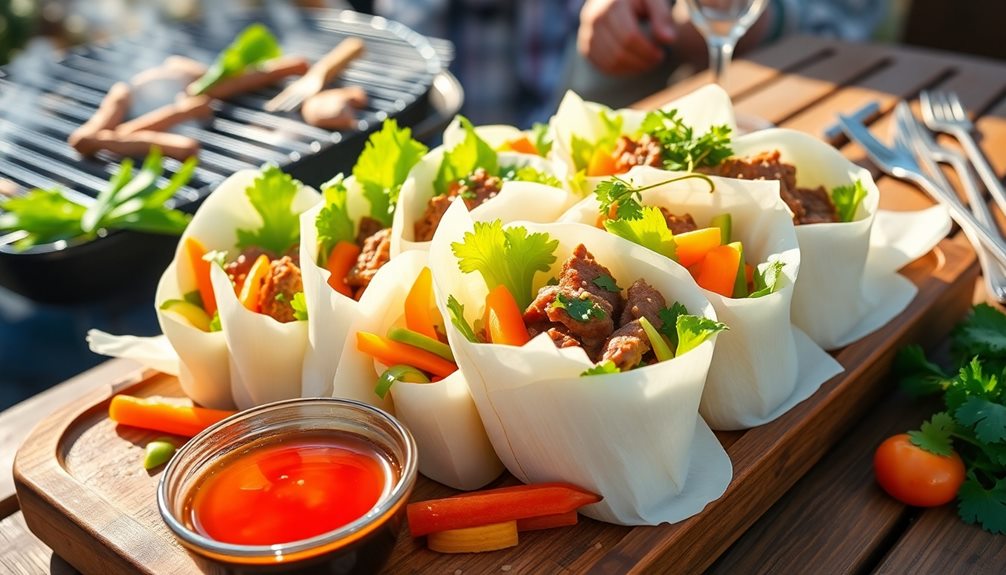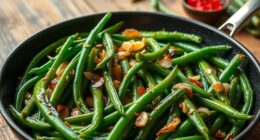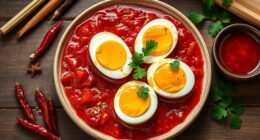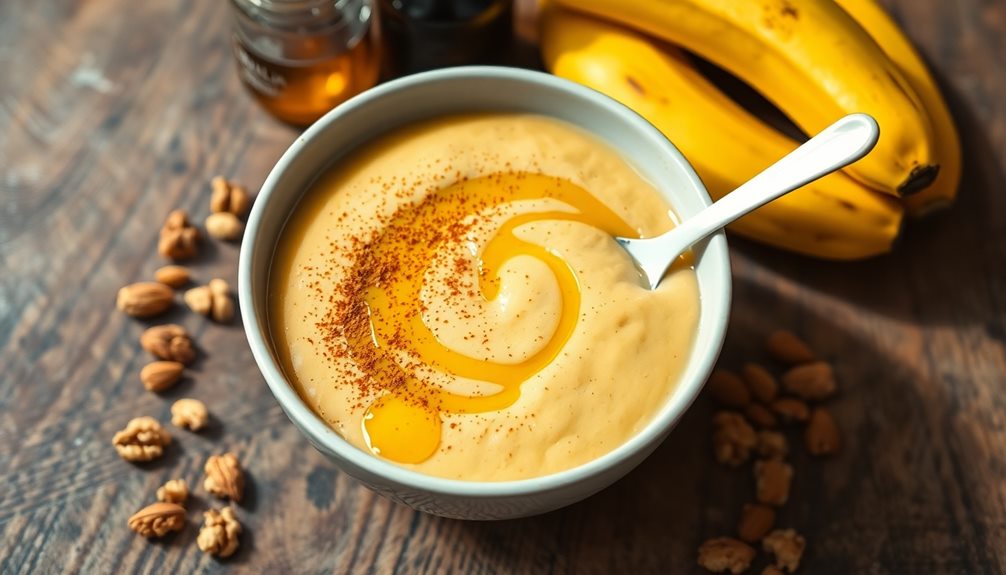Beloved across Korea, the soul-warming sullungtang is a time-honored comfort soup that invites you to savor the rich flavors and cherished traditions of the nation's culinary heritage. This budget-friendly meal evolved over the centuries, with regional variations reflecting local ingredients. Packed with tender beef, savory broth, and chewy noodles, sullungtang is a cherished dish that connects Koreans to their past and brings families together. Slow-simmered to perfection, this nourishing soup fills the kitchen with an aroma that signals cozy and comforting times ahead. Curious to learn more about this beloved Korean classic and how to recreate it in your own kitchen?
Key Takeaways
- Sullungtang is a traditional Korean beef bone broth soup that originated during the Joseon dynasty and has been cherished for its rich, umami-packed flavors.
- The slow cooking process of 3-4 hours is essential for developing the hearty, comforting broth, which is often enjoyed with chewy rice noodles or glass noodles.
- The dish features tender beef chunks, fresh vegetables, and a savory, well-balanced broth that provides a sense of warmth and nourishment, especially during the cold winter months.
- Sullungtang holds deep cultural significance, reflecting Korea's culinary heritage and tradition, often served during family gatherings and special occasions.
- The communal dining experience around the table, along with the aroma and flavors of the dish, helps strengthen familial bonds and emotional connections within Korean culture.
History
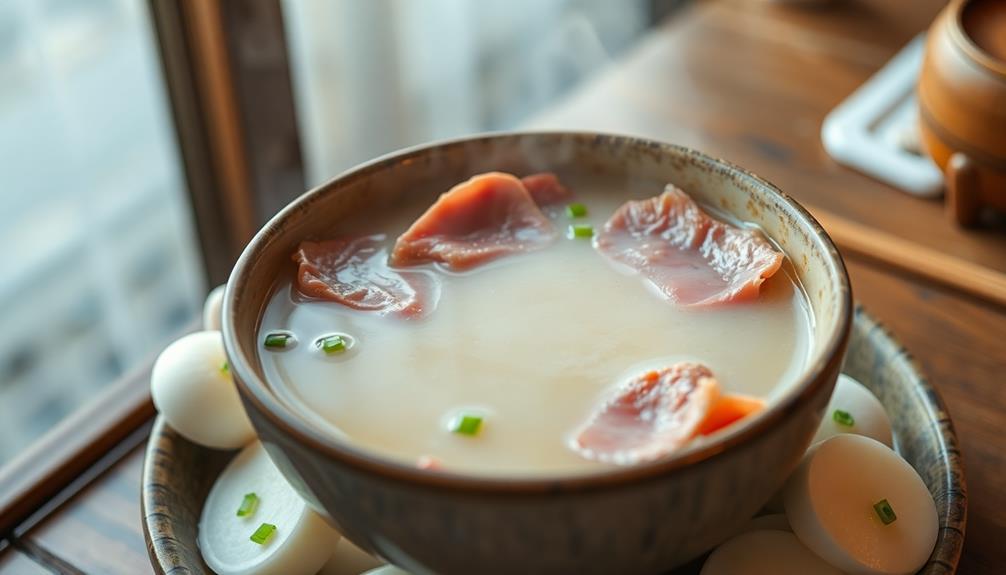
Sullungtang, a beloved Korean comfort soup, has a rich history rooted in the country's culinary traditions. This hearty broth, made from beef bones and brisket, has been a staple dish for centuries, nourishing generations of Koreans.
The origins of sullungtang can be traced back to the Joseon dynasty, when it was commonly enjoyed by the common people. It gained popularity as a budget-friendly meal that could be stretched to feed large families.
Over time, the recipe evolved, with different regions developing their own unique variations, each reflecting the local ingredients and cooking techniques.
Today, sullungtang remains a cherished part of Korean food culture. It's often served at family gatherings, where the simmering pot on the stove brings people together, creating a cozy and comforting atmosphere.
Whether savoring it on a chilly winter day or as a restorative meal, this soul-warming soup continues to be a beloved comfort food that connects Koreans to their rich culinary heritage.
Recipe

Sullungtang, a hearty Korean beef soup, is a beloved comfort food that warms the soul. This soothing dish features tender beef, chewy noodles, and a savory broth that simmers with the flavors of Korea. The key to creating an authentic sullungtang lies in the slow, gentle cooking process, which allows the natural sweetness of the beef to infuse the broth.
At its heart, sullungtang is a simple yet deeply satisfying meal. The long, slow cooking process is essential, as it allows the beef bones to release their rich gelatin, creating a velvety, umami-packed broth. This soup is a testament to the power of patience and the transformative nature of slow, traditional cooking methods.
- 3 pounds beef bones (a combination of marrow and knuckle bones)
- 1 pound beef brisket
- 1 onion, quartered
- 4 cloves garlic, peeled
- 1 inch ginger, sliced
- 1 teaspoon black peppercorns
- 8 cups water
- 1 teaspoon salt, plus more to taste
- 8 ounces chewy rice noodles or Korean glass noodles
- Chopped green onions, for garnish
- Lime wedges, for serving
Begin by placing the beef bones in a large pot and covering them with water. Bring the water to a boil, then reduce the heat and simmer for 30 minutes, skimming any scum that rises to the surface. Drain the bones, discard the water, and return the bones to the pot.
Add the brisket, onion, garlic, ginger, and peppercorns, then pour in 8 cups of fresh water. Bring the pot to a boil, then reduce the heat to low, cover, and simmer gently for 3-4 hours, until the beef is extremely tender.
Remove the brisket from the pot and shred or slice it. Strain the broth through a fine-mesh sieve, discarding the solids. Return the broth to the pot, add the shredded beef, and season with 1 teaspoon of salt, or to taste.
Bring the soup to a simmer, then add the noodles and cook until tender, about 5-7 minutes. Serve the sullungtang hot, garnished with chopped green onions and accompanied by lime wedges for squeezing over the top.
When preparing sullungtang, the low and slow cooking method is essential for developing the rich, velvety broth. Be patient and allow the flavors to meld together over time. The result is a comforting, nourishing soup that embodies the essence of Korean home cooking.
Cooking Steps
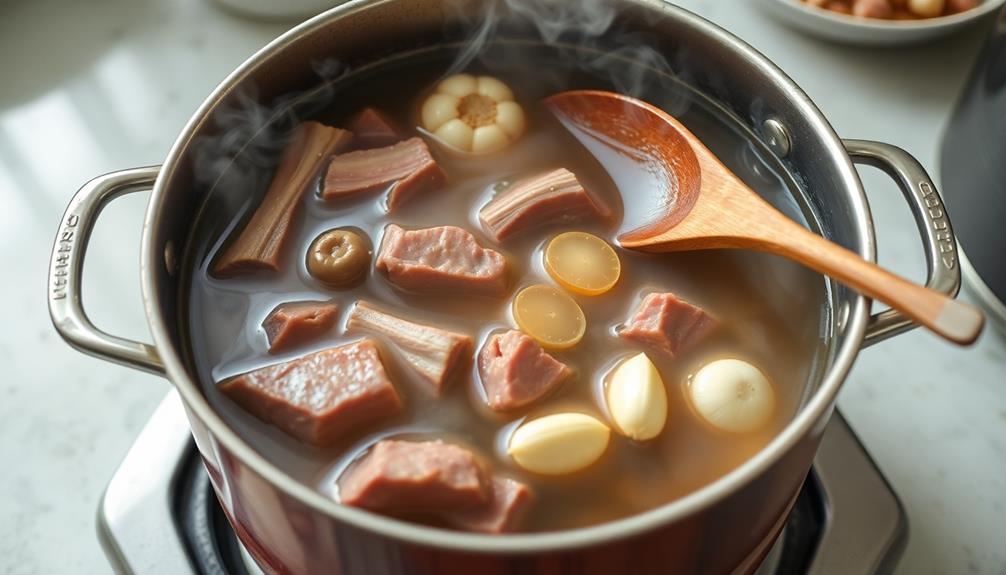
Bring the rich bone-broth to a boil, then add tender beef chunks.
Next, toss in a variety of fresh vegetables.
Finally, adjust the seasoning to suit your taste.
Serve this comforting soup piping hot, alongside a steaming bowl of rice – the perfect pairing for Korea's beloved Sullungtang!
Step 1. Bring Bone-Broth to a Boil

Begin by placing the bones in a large pot and covering them with water.
Bring this flavorful bone broth to a rolling boil over high heat. As it begins to bubble, you'll notice the water transforming into a rich, golden elixir, brimming with the essence of the bones.
Don't be afraid to let it really come to a full boil – this helps extract all the goodness!
Next, reduce the heat to medium-low and let the broth simmer gently for at least 2-3 hours, or up to 8 hours for an even more concentrated flavor.
Skim off any impurities that rise to the surface, ensuring a clear, clean broth.
The longer you can let it simmer, the better – this slow, steady cooking allows the bones to fully break down, releasing all their nourishing collagen and minerals.
Get ready for your kitchen to fill with the most mouthwatering aroma!
Step 2. Add Beef Chunks

Once you've achieved that rich, golden bone broth, it's time to add the beef chunks. This is where the real magic happens! Grab your freshest, most tender beef cuts and cut them into bite-sized pieces. The key is to choose a cut with just the right amount of marbling – not too lean, not too fatty.
Gently drop the beef chunks into the simmering broth and watch as they transform. The heat will coax out all the beefy, umami-packed flavors, infusing the entire soup with irresistible richness. As the beef cooks, it'll become meltingly tender, practically falling apart with your spoon.
Be sure to skim off any foam or impurities that rise to the surface. This will keep your Sullungtang crystal clear and pure.
Now, get ready for the next step – adding the final touch of seasoning that will make this dish truly unforgettable!
Step 3. Add Vegetables

With the beefy broth and tender chunks of meat now ready, you can turn your attention to the vegetables. Start by chopping up some fresh, crisp carrots into bite-sized pieces. These vibrant veggies will add a delightful crunch and natural sweetness to the soup. Carrots aren't only tasty but also packed with vitamins, which can contribute to overall health rich in vitamins A, C, and K.
Next, slice up some earthy, aromatic onions. Their savory flavor will meld beautifully with the other ingredients, creating a harmonious balance.
Don't forget the fragrant garlic – mince a few cloves to infuse the broth with its robust aroma.
For a pop of color and texture, add some sliced cabbage. Its tender yet slightly crunchy leaves will soak up all the delicious broth.
Finally, finish off with a handful of fresh, leafy greens like spinach or kale. These nutrient-packed veggies won't only elevate the soup's nutritional value but also lend a lovely, verdant touch.
With the array of fresh vegetables incorporated, your nourishing and soul-soothing Sullungtang is now complete and ready to enjoy!
Step 4. Adjust Seasoning to Taste
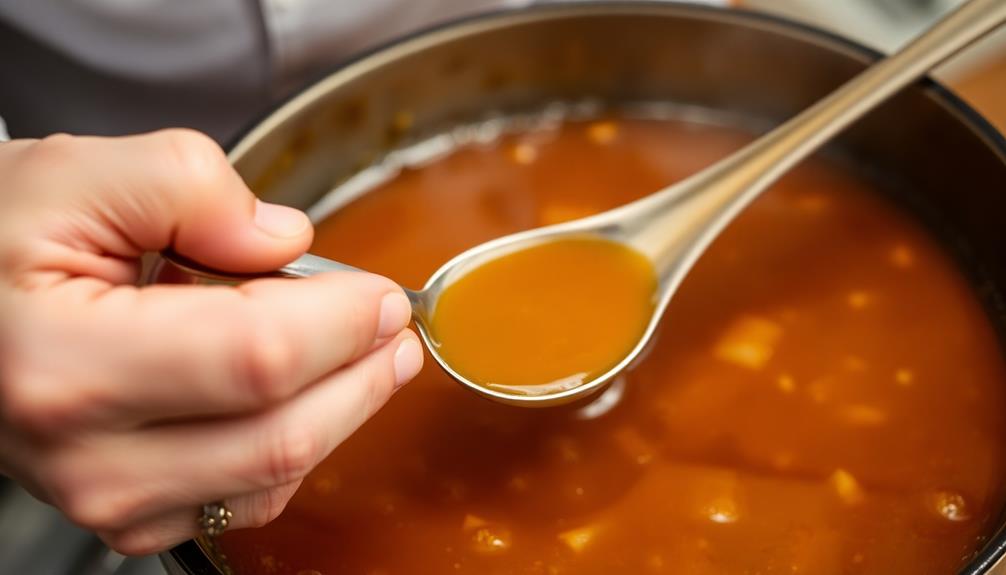
Taste the broth and season it to your liking. Dip your spoon in, take a sip, and decide if it needs a little more salt or pepper.
Don't be afraid to adjust the flavors until it's perfect for your taste buds. This is your dish, so make it your own!
Start with a small amount of seasoning, then add more if needed. A pinch of salt here, a dash of pepper there – play around until the broth is as savory or as peppery as you prefer.
You can also try a sprinkle of garlic powder or a squeeze of lemon juice to brighten up the flavors.
Step 5. Serve Piping Hot With Rice

Serve the piping hot sullungtang over a bed of steaming white rice. The fragrant broth will instantly warm your soul, while the tender beef chunks and chewy rice cakes provide a comforting texture.
Garnish the dish with freshly chopped green onions, whose crisp, vibrant flavor will add a delightful contrast.
Be sure to serve the sullungtang immediately – you'll want to enjoy it at its absolute peak! The heat will release the soup's aromatic spices, creating a mouthwatering aroma that'll have your family gathered around the table in no time.
Pair it with a side of kimchi for a classic Korean meal that's sure to satisfy.
Don't forget to encourage everyone to dig in while the soup is hot. The combination of the savory broth and fluffy rice is a match made in heaven, promising a soul-soothing experience with every spoonful.
Enjoy this beloved Korean comfort food together as a family!
Final Thoughts

Sullungtang is more than just a nourishing soup – it's a cultural tradition that has endured for generations. From the comforting aroma to the tender beef and hearty broth, every spoonful is a delightful journey through Korea's rich culinary heritage.
Whether you're enjoying it with family during a special occasion or savoring it on a chilly day, this soul-warming dish is sure to bring a smile to your face.
As you savor the last few bites, you can't help but feel a sense of connection to the generations before you who've cherished this beloved recipe.
Sullungtang isn't just food; it's a reminder of the power of tradition, the importance of gathering around the table, and the joy of sharing a meal with loved ones.
Frequently Asked Questions
What Is the Typical Serving Size of Sullungtang?
The typical serving size of sullungtang is a hearty bowl, often enough to satisfy your appetite and leave you feeling comforted. The portions are generous, allowing you to savor the rich, warming broth to the last drop.
Can I Substitute Any Ingredients in the Recipe?
You can substitute some ingredients in the sullungtang recipe, but it's best to stick to the traditional ingredients for an authentic flavor. Feel free to experiment with different meats or vegetables, but don't stray too far from the original.
How Long Does the Soup Typically Take to Prepare?
Preparing the soup typically takes around 2 to 3 hours. The lengthy simmering process is what allows the rich, savory broth to develop its deep, comforting flavors. With a bit of patience, you'll have a satisfying meal ready to enjoy.
Is Sullungtang Gluten-Free or Suitable for Dietary Restrictions?
Sullungtang is generally gluten-free, making it suitable for those with dietary restrictions. The broth is simply boiled beef bones and water, without any added wheat-based ingredients. It's a nourishing and comforting soup option for those following a gluten-free diet.
What Are the Best Accompaniments to Serve With Sullungtang?
When serving sullungtang, you'll want to pair it with side dishes like kimchi, seasoned vegetables, and steamed rice. These accompaniments help balance the rich, hearty flavors of the soup. Don't forget the freshly cracked black pepper!
